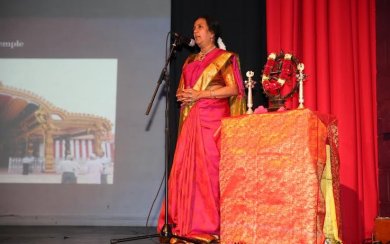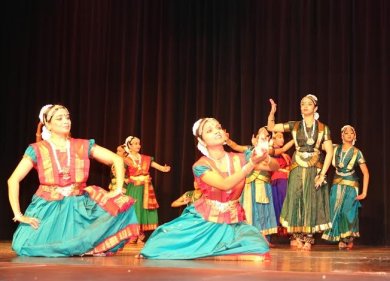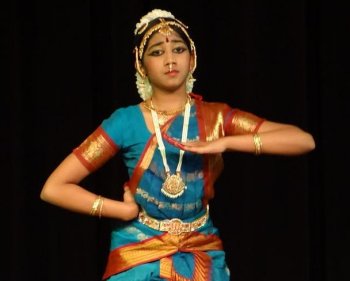
|
 |

|
 |
Panchalinkeswaram: A thematic dance production by Usha Raghavan - Ahilan Sandirasekaram e-mail: modokwon@yahoo.com May 16, 2016 Usha Raghavan presented INIYA NINAIVUGAL (Sweet Memories) by her students of Kalasagara UK, a Bharatanatyam celebration of their dance performance tour of Sri Lanka, last summer. In London, they presented dance compositions as performed in Sri Lanka, followed by a slide show presentation of their experiences during the dance tour. The show concluded with a thematic dance performance on the five major Shiva temples in Sri Lanka known as 'Panchalinkeswaram.' Usha Raghavan shares information about her production.  Usha Raghavan 'Panchalinkeswaram' was a brilliant show that had a series of legends and myths about the Shiva Temples in Sri Lanka. How did you come about choosing a theme like this? Since 2005, I have organized several dance-related heritage tours of South India, taking my students from England and Italy. Last year I extended the tour to Sri Lanka when my students and I were invited to give a series of Bharatanatyam performances over there. Accepting the invitation, I embarked on a dance tour with 12 of my students and gave performances in Jaffna and Colombo. As the tour was a success, I wanted to organize in London, a repeat of our performances in Sri Lanka and share our experiences. In the past, I have heard and read about the stories of the five major Shiva temples in Sri Lanka. I thought that it would be a great opportunity and quite appropriate to present in this show, a dance production based on these five Shiva temples popularly known as 'Panchalinkeswaram.' The format of the thematic production was novel. How did you arrive at this interesting format? I am very keen that every production of mine has some novel aspect in it. Hence, once I had decided the concept, I visualized the flow of the theme in my mind. Though it was about five different temples and varied legends associated with them, I wanted the concept to flow seamlessly. Additionally, I was also studying various sources about these temples to make it an authentic production. With the help of Dr. Siva Kumar, a Tamil scholar, I was able to confirm the authenticity of the legends and episodes I was about to portray. From what I had studied, I gradually fitted every episode as I had envisioned. Much to my amazement, all the five episodes fitted in the format perfectly and beautifully. The lyrics seemed traditional as well as contemporary. How did you choose the songs? The basic compositions on all the five temples - Thirukoneswaram, Thiruketheeswaram, Muniswaram, Naguleswaram and Thiruthondeswaram - were originally penned at my request by my student's father, Mr. Balachandran, for his daughter's arangetram. At my behest, he then added more lyrics as required. As I was reading about the temples, I got to know that there were Thevarams sung on the two shrines in Thirukoneswaram and Thiruketheeswaram. I chose two of the most appropriate to suit the episode portrayed. The entire production was in chaste Tamil. Do you think the next generation of young dancers would be able to understand the legends and lyrics? This is precisely the reason why before starting every scene, I gave a simple narration in English along with a small demonstration by the dancers. This has been a special aspect in all my performances which is appreciated by both connoisseurs as well as the uninitiated alike, as it enables them to follow the dance sequence more in detail. It was interesting to watch how you framed each temple episode by starting and ending each episode with sollukattu swaras, with the story embedded within the borders. The exquisite music for the production contributed to the success of the show. Can you share information on this? Whenever I set music for a thematic dance production, I keep in mind the scene, the character and the emotions portrayed. Then I choose appropriate ragas and talas that would enhance the beauty in the lyrics and the dance itself. For example, I retained the raga Bhoopalam for the Thevaram 'Nirai Kazhal' as it is traditionally sung. However, I chose to use majestic Shanmugapriya for Thirukoneswaram as the raga suited the story of Ravana's lifting of the Shiva Linga. For the first time, I choreographed the entire production on misra chapu talam and introduced different talas and gatibhedam according to the story narrated in between. I am very pleased that this experiment of mine resulted in a very interesting choreography. I believe that a structured sequence adds beauty to a thematic production. Hence I set this format of swaras bordering each episode. There were some notable features about the instruments used. It will be interesting to know the basis of their choice. Since it was a Bharatanatyam based performance, there were the usual artists on the vocals, nattuvangam, mridangam and violin. In addition, I had invited a percussionist for special sound effects like temple bells, chanku, maddalam, Ravana's chariot and so on, to accompany us as appropriate to the scenes. The special effects added superb flavor to the scenes. I must however add that I had to be careful in the selection and usage of the additional instruments so that they were just to enhance the mood of the situation and character shown. 
 This is the second thematic dance production with live orchestra that you have presented back-to-back within a period of just two months this year. In a country like the UK, what are the advantages or difficulties in bringing all artists to work with you on such major productions? In both the productions we were accompanied by local musicians only. We have some very talented artists in the UK. Nevertheless, bringing together musicians and all participating dancers to do a creative production like this is a huge challenge. It requires months of meticulous planning well in advance. It takes time to prepare the dancers and the musicians separately and then bringing them together. Hence, for me, every creative work takes months of sustained work starting from planning and organizing the rehearsals to culminating in the actual performance. Were all dancers your students? Yes, all 15 of them who performed in this production are my students who have been taking part in many of my dance productions. Most of them were those who gave performances in Sri Lanka as part of my tour in 2015. There were no costume changes in between. Is there any reason for it? The costumes were specially made in Chennai. I decided not to use change of costume in between the performance as I felt that that might break the flow of the theme which was all about a single theme on the five Shiva temples. The slide show presentation prior to the performance was interesting and informative. What was the idea behind showing it? In the brief slide show presentation were some of the pictures taken during our dance tour of Sri Lanka. It was truly a memorable experience for us as there were about 600 - 1000 people in the audience attending our show at the various venues. It is this tour that partly motivated the dancers to take part in a production on Sri Lanka. When I decided the concept for the production they all took part in it with enthusiasm and excitement. It was also an emotional experience for many Sri Lankan Tamils in the audience in London who were able to relate to the pictures shown in the slide show but haven't had the possibility to visit their native land in the past few decades. Hence I gave the title 'Iniya Ninaivugal' for the show. Contact Usha Raghavan at: usharaghavan2006@gmail.com Post your comments Unless you wish to remain anonymous, please provide your name and email id when you use the Anonymous profile in the blog to post a comment. All appropriate comments posted with name & email id in the blog will also be featured in the site. |